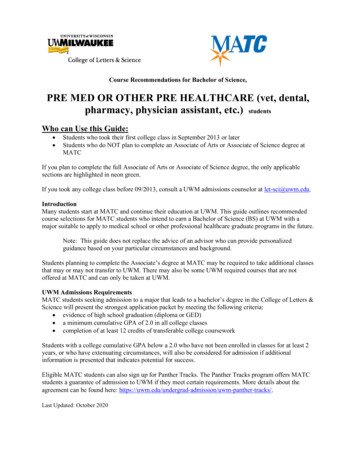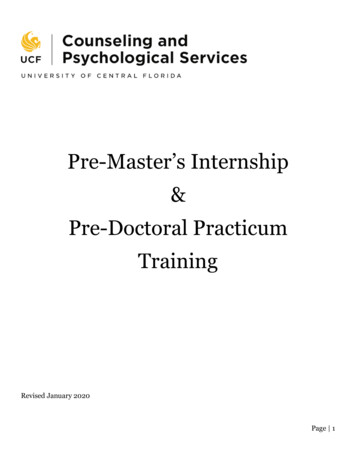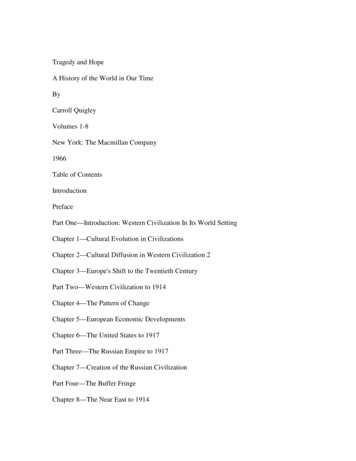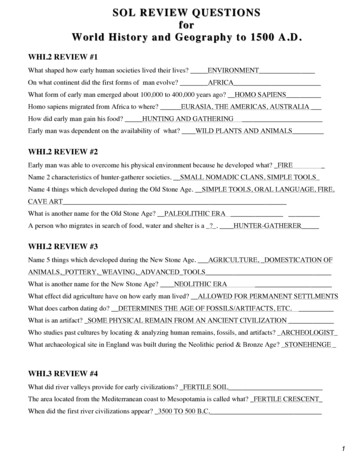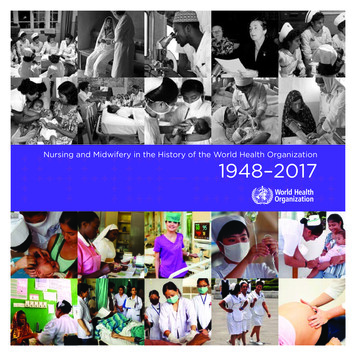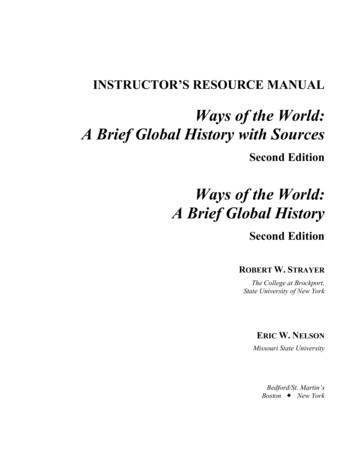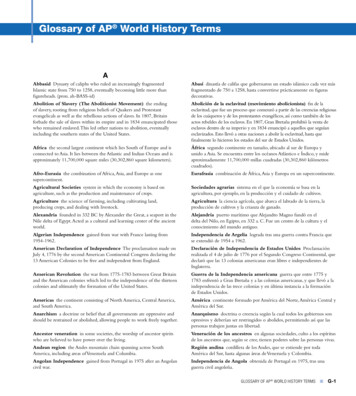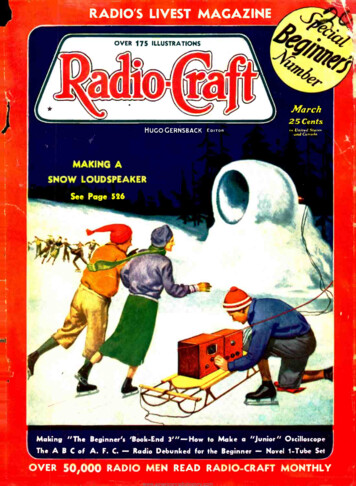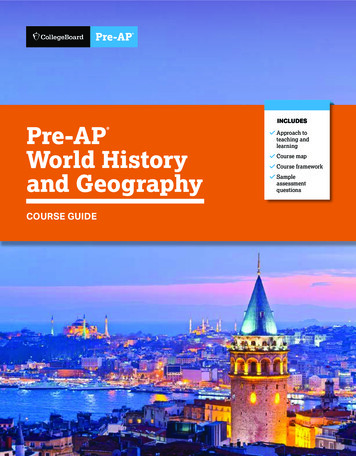
Transcription
Pre-APWorld Historyand Geography COURSE GUIDEINCLUDESApproach toteaching andlearningCourse mapCourse frameworkSampleassessmentquestions
Pre-APWorld Historyand Geography COURSE GUIDEUpdated Fall 2020Please visit Pre-AP online at preap.collegeboard.org for more information and updates aboutthe course and program features.
ABOUT COLLEGE BOARDCollege Board is a mission-driven not-for-profit organization that connects students to collegesuccess and opportunity. Founded in 1900, College Board was created to expand accessto higher education. Today, the membership association is made up of over 6,000 of theworld’s leading educational institutions and is dedicated to promoting excellence and equityin education. Each year, College Board helps more than seven million students prepare fora successful transition to college through programs and services in college readiness andcollege success—including the SAT and the Advanced Placement Program . The organizationalso serves the education community through research and advocacy on behalf of students,educators, and schools.For further information, visit www.collegeboard.org.PRE-AP EQUITY AND ACCESS POLICYCollege Board believes that all students deserve engaging, relevant, and challenging gradelevel coursework. Access to this type of coursework increases opportunities for all students,including groups that have been traditionally underrepresented in AP and college classrooms.Therefore, the Pre-AP program is dedicated to collaborating with educators across the countryto ensure all students have the supports to succeed in appropriately challenging classroomexperiences that allow students to learn and grow. It is only through a sustained commitment toequitable preparation, access, and support that true excellence can be achieved for all students,and the Pre-AP course designation requires this commitment.ISBN: 978-1-4573-1441-4 2021 College Board. PSAT/NMSQT is a registered trademark of College Board and National MeritScholarship Corporation.1 2 3 4 5 6 7 8 9 10
ContentsvAcknowledgmentsABOUT PRE-AP33Introduction to Pre-APDeveloping the Pre-AP Courses4How to Get Involved3Pre-AP Educator Network55Pre-AP Approach to Teaching and LearningFocused Content7Targeted Assessments for Learning58Horizontally and Vertically Aligned InstructionPre-AP Professional LearningABOUT PRE-AP WORLD HISTORY AND GEOGRAPHY1111Introduction to Pre-AP World History and GeographyPre-AP World History and Geography Areas of Focus16Summary of Resources and Supports15171820Pre-AP World History and Geography and Career ReadinessPre-AP World History and Geography: Two PathwaysCourse Map: Pathway 1Course Map: Pathway 22222Pre-AP World History and Geography Course FrameworkIntroduction25Areas of Focus: Connected Disciplinary Skills2327293134374043464748Course Framework ComponentsGeography and World RegionsThe Ancient Period, to c. 600 BCEThe Classical Period, c. 600 BCE to c. 600 CEThe Postclassical Period, c. 600 to c. 1450The Early Modern Period, c. 1450 to c. 1750The Modern Period, c. 1750 to c. 1914The Contemporary Period, c. 1914 to the PresentThemes in Pre-AP World History and GeographyPre-AP World History and Geography Model LessonsSupport Features in Model Lessons
4949Pre-AP World History and Geography Assessments for LearningLearning Checkpoints51Sample Performance Task and Scoring Guidelines5065677274Performance TasksFinal ExamSample Assessment ItemsPre-AP World History and Geography Course DesignationAccessing the Digital Materials
AcknowledgmentsCollege Board would like to acknowledge the following committee members, consultants, andreviewers for their assistance with and commitment to the development of this course. Allindividuals and their affiliations were current at the time of contribution.Sarah Bednarz, Texas A&M University (retired), College Station, TXJonathan Ferrante, Smithtown High School West, Smithtown, NYGail Hamilton, Bancroft Middle School, Long Beach, CAJonathan Henderson, Forsyth Central High School, Cumming, GATim Keirn, California State University, Long Beach, Long Beach, CAMedha Kirtane, Ridgewood High School, Ridgewood, NJSamantha Kowalak, Livingston High School, Livingston, NJChris Peek, Bellaire High School, Bellaire, TXSean Robertson (deceased), Harlem Academy Middle School, Harlem, NYBrenda Santos, Achievement First Schools, Providence, RIChristina Suarez, Lake Region Union High School, Orleans, VTKevin Witte, Kearney High School, Kearney, NECOLLEGE BOARD STAFFDrew McCulley, Director, Pre-AP Curriculum, Instruction, and AssessmentJoely Negedly, Senior Director, Pre-AP Curriculum, Instruction, and AssessmentBeth Hart, Senior Director, Pre-AP AssessmentLaura Smith, Director, Pre-AP AssessmentNatasha Vasavada, Executive Director, Pre-AP Curriculum, Instruction, and Assessment
About Pre-AP
About Pre-APIntroduction to Pre-APEvery student deserves classroom opportunities to learn, grow, and succeed. College Boarddeveloped Pre-AP to deliver on this simple premise. Pre-AP courses are designed to supportall students across varying levels of readiness. They are not honors or advanced courses.Participation in Pre-AP courses allows students to slow down and focus on the most essentialand relevant concepts and skills. Students have frequent opportunities to engage deeply withtexts, sources, and data as well as compelling higher-order questions and problems. AcrossPre-AP courses, students experience shared instructional practices and routines that helpthem develop and strengthen the important critical thinking skills they will need to employ inhigh school, college, and life. Students and teachers can see progress and opportunities forgrowth through varied classroom assessments that provide clear and meaningful feedback atkey checkpoints throughout each course.DEVELOPING THE PRE-AP COURSESPre-AP courses are carefully developed in partnership with experienced educators, includingmiddle school, high school, and college faculty. Pre-AP educator committees work closelywith College Board to ensure that the course resources define, illustrate, and measure grade-level-appropriate learning in a clear, accessible, and engaging way. College Board also gathersfeedback from a variety of stakeholders, including Pre-AP partner schools from across thenation who have participated in multiyear pilots of select courses. Data and feedback frompartner schools, educator committees, and advisory panels are carefully considered to ensurethat Pre-AP courses provide all students with grade-level-appropriate learning experiencesthat place them on a path to college and career readiness.PRE-AP EDUCATOR NETWORKSimilar to the way in which teachers of Advanced Placement (AP ) courses can becomemore deeply involved in the program by becoming AP Readers or workshop consultants, PreAP teachers also have opportunities to become active in their educator network. Each year,College Board expands and strengthens the Pre-AP National Faculty—the team of educatorswho facilitate Pre-AP Readiness Workshops and Pre-AP Summer Institutes. Pre-AP teacherscan also become curriculum and assessment contributors by working with College Board todesign, review, or pilot course resources.Course Guide 2021 College Board3Pre-AP World History and Geography
About Pre-APIntroduction to Pre-APHOW TO GET INVOLVEDSchools and districts interested in learning more about participating in Pre-AP should visitpreap.collegeboard.org/join or contact us at preap@collegeboard.org.Teachers interested in becoming members of Pre-AP National Faculty or participating incontent development should visit preap.collegeboard.org/national-faculty or contact us atpreap@collegeboard.org.Pre-AP World History and Geography4Course Guide 2021 College Board
About Pre-APPre-AP Approach to Teaching and LearningPre-AP courses invite all students to learn, grow, and succeed through focused content,horizontally and vertically aligned instruction, and targeted assessments for learning. ThePre-AP approach to teaching and learning, as described below, is not overly complex, yet thecombined strength results in powerful and lasting benefits for both teachers and students.This is our theory of action.Horizontally andVertically AlignedInstructionShared Principles,Areas of FocusFocused ContentCourse Frameworks,Model LessonsTargeted Assessmentsand FeedbackLearning Checkpoints,Performance Tasks,Final ExamFOCUSED CONTENTPre-AP courses focus deeply on a limited number of concepts and skills with the broadestrelevance for high school coursework and college and career success. The course frameworkserves as the foundation of the course and defines these prioritized concepts and skills. Pre-AP model lessons and assessments are based directly on this focused framework. The coursedesign provides students and teachers with intentional permission to slow down and focus.HORIZONTALLY AND VERTICALLY ALIGNED INSTRUCTIONShared principles cut across all Pre-AP courses and disciplines. Each course is also alignedto discipline-specific areas of focus that prioritize the critical reasoning skills and practicescentral to that discipline.Course Guide 2021 College Board5Pre-AP World History and Geography
About Pre-APPre-AP Approach to Teaching and LearningSHARED PRINCIPLESAll Pre-AP courses share the following set of research-supported instructional principles.Classrooms that regularly focus on these cross-disciplinary principles allow students toeffectively extend their content knowledge while strengthening their critical thinking skills.When students are enrolled in multiple Pre-AP courses, the horizontal alignment of the sharedprinciples provides students and teachers across disciplines with a shared language fortheir learning and investigation, and multiple opportunities to practice and grow. The criticalreasoning and problem-solving tools students develop through these shared principles arehighly valued in college coursework and in the workplace.Close Observationand ngSHAREDPRINCIPLESAcademicConversationCLOSE OBSERVATION AND ANALYSISStudents are provided time to carefully observe one data set, text, image, performance piece,or problem before being asked to explain, analyze, or evaluate. This creates a safe entrypoint to simply express what they notice and what they wonder. It also encourages studentsto slow down and capture relevant details with intentionality to support more meaningfulanalysis, rather than rushing to completion at the expense of understanding.HIGHER-ORDER QUESTIONINGStudents engage with questions designed to encourage thinking that is elevated beyondsimple memorization and recall. Higher-order questions require students to make predictions,synthesize, evaluate, and compare. As students grapple with these questions, they learn thatbeing inquisitive promotes extended thinking and leads to deeper understanding.EVIDENCE-BASED WRITINGWith strategic support, students frequently engage in writing coherent arguments fromrelevant and valid sources of evidence. Pre-AP courses embrace a purposeful and scaffoldedapproach to writing that begins with a focus on precise and effective sentences beforeprogressing to longer forms of writing.Pre-AP World History and Geography6Course Guide 2021 College Board
About Pre-APPre-AP Approach to Teaching and LearningACADEMIC CONVERSATIONThrough peer-to-peer dialogue, students’ ideas are explored, challenged, and refined. Asstudents engage in academic conversation, they come to see the value in being open tonew ideas and modifying their own ideas based on new information. Students grow as theyfrequently practice this type of respectful dialogue and critique and learn to recognize that allvoices, including their own, deserve to be heard.AREAS OF FOCUSThe areas of focus are discipline-specific reasoning skills that students develop and leverageas they engage with content. Whereas the shared principles promote horizontal alignmentacross disciplines, the areas of focus provide vertical alignment within a discipline, givingstudents the opportunity to strengthen and deepen their work with these skills in subsequentSocial StudiesScienceMathematicsEnglishArtscourses in the same discipline.Areas of FocusAlign Vertically Within Disciplines(Grades 6-12)Academic ConversationHigher-Order QuestioningEvidence-Based WritingClose Observation and AnalysisShared PrinciplesAlign Horizontally Across All CoursesFor a detailed description of the Pre-AP World History and Geography areas of focus, seepage 11.TARGETED ASSESSMENTS FOR LEARNINGPre-AP courses include strategically designed classroom assessments that serve as toolsfor understanding progress and identifying areas that need more support. The assessmentsprovide frequent and meaningful feedback for both teachers and students across each unit ofthe course and for the course as a whole. For more information about assessments in Pre-APWorld History and Geography, see page 49.Course Guide 2021 College Board7Pre-AP World History and Geography
About Pre-APPre-AP Professional LearningThe summer before their first year teaching a Pre-AP course, teachers are required to engagein professional learning offered by the College Board. There are two options to meet thisrequirement: the Pre-AP Summer Institute (Pre-APSI) and the Online Foundational ModuleSeries. Both options provide continuing education units to educators who complete thetraining. The Pre-AP Summer Institute is a four-day collaborative experience that empowersparticipants to prepare and plan for their Pre-AP course. While attending, teachers engagewith Pre-AP course frameworks, shared principles, areas of focus, and sample modellessons. Participants are given supportive planning time where they work with peers tobegin to build their Pre-AP course plan. The Online Foundational Module Series will be available beginning July 2020 to allteachers of Pre-AP courses. These 12- to 20-hour courses will support teachers inpreparing for their Pre-AP course. Teachers will explore course materials and experiencemodel lessons from the student’s point of view. They will also begin to plan and build theirown course materials, so they are ready on day one of instruction.Pre-AP teachers also have access to the Online Performance Task Scoring Modules, whichoffer guidance and practice applying Pre-AP scoring guidelines to student work.Pre-AP World History and Geography8Course Guide 2021 College Board
About Pre-APWorld History and Geography
About Pre-AP World History and GeographyIntroduction to Pre-AP World Historyand GeographyPre-AP World History and Geography focuses deeply on the concepts and skills that havemaximum value for high school, college, careers, and civic life. The course builds students’essential skills and helps to prepare them for a range of AP history and social sciencecoursework during high school, including AP Human Geography and all three AP historycourses. The learning model is that of an apprenticeship. Primary and secondary sources takecenter stage in the classroom, and students use the tools of the historian and geographer toexamine questions and build arguments.PRE-AP WORLD HISTORY AND GEOGRAPHY AREAS OF FOCUSThe Pre-AP World History and Geography areas of focus, described below, are practicesthat students develop and leverage as they engage with content. These areas of focus arevertically aligned to the practices embedded in other history and geography courses in highschool, including AP, and in college, giving students multiple opportunities to strengthenand deepen their work with these skills throughout their educational career. The verticalprogression of these disciplinary practices is delineated in the course framework beginning onpage 25.IncorporatingEvidenceEvaluatingEvidenceCourse Guide 2021 College BoardWorld Historyand GeographyAreas of Focus11ExplainingHistorical andGeographicRelationshipsPre-AP World History and Geography
About Pre-AP World History and GeographyAbout Pre-AP World History and GeographyIntroduction to Pre-AP World History and GeographyPre-AP World History and Geography Course FrameworkEVALUATINGEVIDENCEAREAS OF FOCUS:CONNECTED DISCIPLINARY SKILLSThe following tables articulate the disciplinary skills that students should develop whileStudentsacquire knowledge by evaluating evidence from a wide range of primary andbuildingknowledgesecondary sources.of each unit's key concepts. Each skill is aligned to a Pre-AP World Historyand Geography area of focus and assessed through the learning checkpoints, performanceHistorians and geographers do not merely examine sources for the purposes of acquiringtasks, and final exam.knowledge; they seek to understand and form arguments about historical perspectives. Likethesedisciplinaryexperts,studentslearn theto determinea source’svalueby askingdisciplinaryCourseassessmentsare designedaroundgoal that studentsfullymasterthe skillsinquestions.This forskillsgeographiccontext,howWhileaudiencethe left columndemonstrateproficiencyin the centercolumn.andpurposeinfluencethe author'schoices, inandthe degreeto which pieces scaffolds,of evidencethe skillsin theright columnmay be exploredPre-APwith t proficiency of these skills is a goal reserved for AP courses.understanding of key concepts and fosters informed citizenship.Evaluating EvidenceAnalyzing Primary SourcesIdentify relevantinformation in a sourceIdentify and explain a source’spoint of view, purpose,historical situation, and/oraudience.Analyzing Secondary SourcesIdentify a key claimand/or argument in asource.Explain how the authorsupports a claim or argumentwith evidence.Assessing Patterns in Quantitative and Qualitative EvidenceIdentify basic patternsfound in evidence.Course Guide 20212021 CollegeCollege BoardBoard Pre-AP World History and GeographyWHG CG CONF.indd 2525WHG CG CONF.inddExplain patterns and identifypotential contradictions foundin evidence.2512Explain the significance ofa source’s point of view,purpose, historical situation,and/or audience, includinghow these might limit theuse(s) of a source.Explain how additionalevidence can support,modify, or refute a source’sclaim or argument.Explain the degree to whichpatterns or contradictionsfound in evidence can beplausibly interpreted.Pre-AP World History and GeographyCourse Guide 2021 College Board18/03/20 4:264:26 PMPM18/03/20
About Pre-AP World History and GeographyIntroduction to Pre-AP World History and GeographyEXPLAINING HISTORICAL AND GEOGRAPHIC RELATIONSHIPSStudents explain relationships among events and people by marshaling evidence forcausation, comparison, and continuity and change over time.History and geography are investigative disciplines. Regularly pursuing inquiries of comparison,causation, and continuity and change over time helps students build the investigative techniquesAbout Pre-AP WorldHistoryand Geographyusedby historiansand geographers. With practice, these techniques become habits of mind.As andstudentslearn tosee relationshipsPre-AP World HistoryGeographyCourseFramework between and among developments, they can begin toexamine questions of historical and geographic significance within the context of specific placesor times.Explaining Historical and Geographic RelationshipsCausationIdentify causes andeffects of a specifichistorical/geographicdevelopment orprocess.Explain relationships betweencauses and effects ofspecific historical/geographicdevelopments or processes.Explain the relativeimportance of differentcauses and effects ofspecific historical/geographicdevelopments or processes.Explain relevant similaritiesand/or differences betweenspecific historical/geographicdevelopments or processes.Explain how similaritiesand differences betweenhistorical/geographicdevelopments or processesreflect underlying factors ortrends.ComparisonIdentify the similaritiesand/or differencesbetween historical/geographicdevelopments orprocesses.Continuity and Change over TimeIdentify patterns ofcontinuity and/orchange over time.Explain patterns of continuityand/or change over time.Explain significant turningpoints and broad patternsof continuity within a giventime and place.Write a defensible claimthat establishes a line ofreasoning.Write a defensible claimthat incorporates diverseevidence and addressescounterclaims to develop acomplex argument.Explain how specificexamples of historicallyrelevant evidence support anargument.Explain how specificexamples of historicallyrelevant evidence support anargument while accountingfor contradictory evidence.Incorporating EvidenceClaimsWrite a defensibleclaim.Supporting EvidenceDescribe specificexamples of historicallyrelevant evidence.Course GuideContextualization 2021 College BoardDescribe a historical/geographic contextfor a specific13Explain how a specifichistorical/geographicdevelopment or process isPre-AP World History and GeographyExplain how broadercontexts inform a historical/
effects of a specifichistorical/spatialdevelopment orprocess.causes and effects ofspecific historical/spatialdevelopments or processes.About Pre-AP World History and Geographyimportance of differentcauses and effects ofspecific historical/geographicdevelopments or processes.Introduction to Pre-AP ComparisonWorld History and GeographyIdentify the similaritiesExplain relevant similaritiesExplain how similaritiesand/or differencesand/or differences betweenand differences betweenbetween historical/specific icdevelopments or processesINCORPORATINGEVIDENCEdevelopments or processes.developments orreflect underlying factors orprocesses.trends.Studentsdemonstrate command of quantitative, qualitative, andspatial data byeffectively incorporating them into written and oral arguments.Continuity and Change over TimeWriting or presenting arguments in history and geography requires more than summarizingIdentifypatternsof argumentsExplainof oundreliespatternsupon effectivelyconnectingevidencein andbroadpatternsof a clear, nuanced thesis. The ability to establish a line of reasoning by deftly framing andchange over time.of continuity within a givenorganizing evidence is a valuable skill that requires ample opportunities for practice andtime and place.feedback. It is a skill students will carry forward into college, career, and civic settings.Incorporating EvidenceClaimsWrite a defensibleclaim.Write a defensible claimthat establishes a line ofreasoning.Write a defensible claimthat incorporates diverseevidence and addressescounterclaims to develop acomplex argument.Explain how specificexamples of historicallyrelevant evidence support anargument.Explain how specificexamples of historicallyrelevant evidence support anargument while accountingfor contradictory evidence.Explain how a specifichistorical/geographicdevelopment or process issituated within a broaderhistorical context.Explain how broadercontexts inform a historical/geographic development orprocess.Supporting EvidenceDescribe specificexamples of historicallyrelevant evidence.ContextualizationDescribe a historical/geographic contextfor a specifichistorical/geographicdevelopment orprocess.Pre-AP World History and Geography26WHG CG CONF.indd 26Pre-AP World History and GeographyCourse Guide 2021 College Board18/03/20 4:26 PM14Course Guide 2021 College Board
About Pre-AP World History and GeographyIntroduction to Pre-AP World History and GeographyPRE-AP WORLD HISTORY AND GEOGRAPHY AND CAREER READINESSThe study of world history and geography offers unique, discipline-specific benefits that arerelevant to students’ lives as well as to a range of career pursuits. Beyond preparing the nextgeneration for careers in history, geography, political science, and economics, the course isdesigned to help all students become more astute consumers of information as they learn toregularly apply the skills and contexts associated with each discipline.Content and skills related to history and geography have numerous connections to life experiences.For example, students may apply these skills when reacting to front-page news stories, evaluatingthe merits of proposed policies, or actively applying historical and geographic thinking andknowledge in the career fields of government, public policy, economics, and law.Career clusters and career examples related to history and geography are provided below.Teachers may consider discussing these with students throughout the year to promotemotivation and engagement.Career Clusters Related to History and/or Geographyagriculture, food, and natural resourcesarchitecture and constructiongovernment and public administrationmanufacturingtransportation, distribution, and logisticsExamples of Careers Related to History and GeographyarchivistseconomistsForeign Service Officersgeographersgeographic informational systems (GIS) specialistsgovernment executives and legislatorshistorianslawyers and judgesmarket and survey researcherspolitical scientistsstrategic operations managersurban and regional plannersIn addition to traditional careers above, newer careers such as data analysts and socialtechnologists are also related to skills developed in history and geography courses.Source for Career Clusters: “Advanced Placement and Career and Technical Education: Working Together.”Advance CTE and the College Board. October 2018. r more information about careers related to history and geography, teachers and studentscan visit and explore the College Board’s Big Future resources: bigfuture.collegeboard.org/majors/history-history and geography.Course Guide 2021 College Board15Pre-AP World History and Geography
About Pre-AP World History and GeographyIntroduction to Pre-AP World History and GeographySUMMARY OF RESOURCES AND SUPPORTSTeachers are strongly encouraged to take advantage of the full set of resources and supportsfor Pre-AP World History and Geography, which are summarized below. Some of theseresources must be used for a course to receive the Pre-AP Course Designation. To learn moreabout the requirements for course designation, see details below and on page 72.COURSE FRAMEWORKIncluded in this guide as well as in the Pre-AP World History and Geography TeacherResources, the framework defines what students should know and be able to do by theend of the course. It serves as an anchor for model lessons and assessments, and it is theprimary document teachers can use to align instruction to course content. Use of the courseframework is required. For more details see page 22.MODEL LESSONSTeacher resources, available in print and online, include a robust set of model lessons thatdemonstrate how to translate the course framework, shared principles, and areas of focus intodaily instruction. Use of the model lessons is encouraged but not required. For more detailssee page 47.LEARNING CHECKPOINTSAccessed through Pre-AP Classroom, these short formative assessments provide insight intostudent progress. They are automatically scored and include multiple-choice and technologyenhanced items with rationales that explain correct and incorrect answers. Use of onelearning checkpoint per unit is required. For more details see page 49.PERFORMANCE TASKSAvailable in the printed teacher resources as well as on Pre-AP Classroom, performance tasksallow students to demonstrate their learning through extended problem-solving, writing,analysis, and/or reasoning tasks. Scoring guidelines are provided to inform teacher scoring,with additional practice and feedback suggestions available in online modules on Pre-APClassroom. Use of each unit’s performance task is required. For more details see page 50.FINAL EXAMAccessed through Pre-AP Classroom, the final exam serves as a classroom-based,summative assessment designed to measure students’ success in learning and applying theknowledge and skills articulated in the course framework. Administration of the final exam isencouraged but not required. For more details see page 65.PROFESSIONAL LEARNINGBoth the four-day Pre-AP Summer Institute (Pre-APSI) and the Online Foundational ModulesSeries support teachers in preparing and planning to teach their Pre-AP course. All PreAP teachers are required to either attend the Pre-AP Summer Institute or completethe module series. In addition, teachers are required to complete at least one OnlinePerformance Task Scoring module. For more details see page 8.Pre-AP World History and Geography16Course Guide 2021 College Board
About Pre-AP World History and GeographyIntroduction to Pre-AP World History and GeographyPRE-AP WORLD HISTORY AND GEOGRAPHY: TWO PATHWAYSBefore implementing the Pre-AP World History and Geography course, schools select one oftwo available pathways. This encourages a deep study of a few historical periods and providesan opportunity for schools to choose the pathway that is the best fit for their state standardsand district course sequences. Model lessons and assessments are based on the selectedpathway. Both pathways begin with the study of geography and world regions. Pathway 1 moves from geography and world regions to developments in world historyfrom the ancient period through c. 1450 CE. Pathway 2 moves from geography and world regions to developments in world historyfrom c.1450 CE through the present.Ancient Periodto c. 600 BCEClassical Periodc. 600 BCE to c. 600 CEPostclassical Periodc. 600 to c. 1450Early Modern Periodc. 1450 to c. 1750Modern Periodc. 1750 to c. 1914Contemporary Periodc. 1914 to the PresentPathway 1Geography andWorld RegionsPathway 2Course Guide 2021 College Board17Pre-AP World History and Geography
Geogra
37 The Early Modern Period, c. 1450 to c. 1750 40 The Modern Period, c. 1750 to c. 1914 43 The Contemporary Period, c. 1914 to the Present 46 Themes in Pre-AP World History and Geography 47 Pre-A
